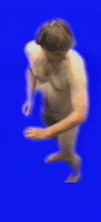| Hangolás (Tuning) |

2000, videoinstalláció, hang nélkül
verzió 3.0: három fülke, verzió 2.0: két fülke, verzió 1.0: egy fülke (helyspecifikus)
Tuning 3.0: DVD 4'10", 3 példány + mastercopy
hátulról megvilágított vetítõvászon, négy kék fal; 225x300x120cm
Media Factory, Pécs, 2004
Subjectiv Space, Konsumverein, Braunschweig, 2003
Tuning 3.0, U.F.F. Galéria, Budapest/Hungary, 1999
Fictive Reality, Budapest Gallery, Budapest, 2000
Out of Shape (version 2.0), Municipal Art Museum, Győr, 2000
Impulse (version 1.0), Protokoll Gallery, Cluj, 2000
| Sajtótükör |

Sándor Hornyik
Műertő, Budapest, június 2000
Videospace Budapest
(...) Video as an artistic means of presentation by now looks back on a past of several decades, while our visual world shaped by video has become a determinig factor of our culture in the past ten years. (...) Video installation as a medium and the Out of Shape exhibition lead us to revise our expectations concerning images appearing on the screen. (...)
Hajnal Németh's Twice Good Night and Eike's Tuning are apparently successful re- and deformations, which, characteristically of installations, involve the surrounding space. In Twice Good Night, the image is projected on the convex backside of a parabola dish, while in Tuning, niches replace the screen. In line with the very nature of the genre of videoinstallation, the themes of the works are essentially topical: Németh's video exudes the air of music channels (pop music, techno images, slow camera movement, shocking cuts and shifts of sounds and images); while Eike juggles with merging real and virtual space (a living sculpture-like figure fading in the blue-box background). Gyula Várnai is up-to-date in another way: he focuses on the questions of epistemology. In the exhibition in Győr we can see one of his most popular works, The Shadow of the Moon. A wooden chair's shadow, formed of dominoes, remains invisible for the closed circuit camera. The philosophical duality of the objective and the subjecitve is being questioned here by way of replacing it with something else - in a very attractive way. (...)